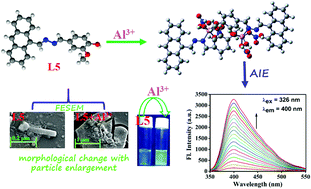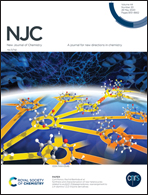Al3+ triggered aggregation induced emission of an anthracence based azine derivative in SDS medium†
Abstract
An anthracene based unsymmetrical azine derivative, viz. 4-(anthracen-9-ylmethylene-hydrazonomethyl)-2-methoxy-phenol (L5), is synthesized and structurally characterized by single crystal X-ray diffraction (SC-XRD) analysis. The photo-physical interaction of L5 with Al3+ in sodium dodecyl sulfate (SDS) is highly selective, allowing recognition of nanomolar (62.8 nM) Al3+ without interference from common cations. The Job plot shows a 1 : 1 (mole ratio) interaction with an associated binding constant of 9.14 × 104 M−1. The “turn ON” fluorescence is attributed to aggregation induced emission (AIE). The Al3+ assisted particle size enhancement of L5 from 52.70 nm to 3413.06 nm (3.413 μM) observed through DLS studies corroborates the AIE mechanism. FESEM images also support the proposed mechanism. The cylindrical morphology of L5 changes to a cube shape due to aggregation of the [Al3+ + L5] adduct. Fluorescence lifetime decay (TCSPC) data indicate that the radiative decay of L5 is enhanced about ten times in the presence of Al3+. The average lifetime of L5 in the absence and presence of Al3+ is 0.98 ns and 1.45 respectively. In the presence of Na2EDTA, the emission intensity of the [L5 + Al3+] system is significantly quenched due to chelation of Al3+ by EDTA. TDDFT studies indicate higher stability of the [L5 + Al3+] adduct over free L5.



 Please wait while we load your content...
Please wait while we load your content...